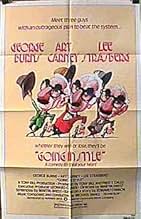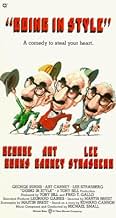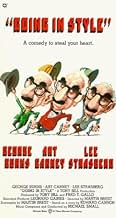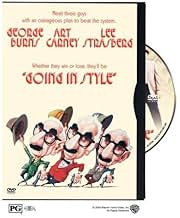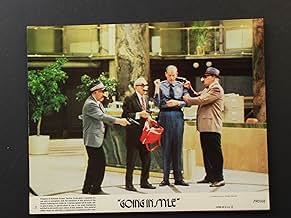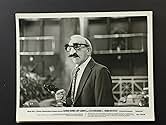IMDb RATING
7.1/10
4.3K
YOUR RATING
Three friends living on the dole decide to rob a bank.Three friends living on the dole decide to rob a bank.Three friends living on the dole decide to rob a bank.
- Awards
- 1 win & 1 nomination total
Pamela Payton-Wright
- Kathy
- (as Pamela Payton Wright)
- Director
- Writers
- All cast & crew
- Production, box office & more at IMDbPro
Featured reviews
Joe, Al and Willie (George Burns, Art Carney and Lee Strasberg) are three elderly pensioners who live together to save money. But money is still very tight and they lead very simple, predictable lives. One day, Joe announces to his friends that he's planning on committing a robbery. After all, if it's successful their money problems are over, and if it isn't, they get a free place to live! Well, considering their situations, Joe is right...what do they have to lose?
"Going in Style" was remade a few years ago and I was rather indifferent towards the film...and my review called it 'thoroughly adequate'. It was okay...but nothing special. Plus, it was a remake. So what do I think about the original? Is it better, is it worse...or is it pretty much the same?
The cast for this film (as well as the remake) is impressive. George Burns and Art Carney are both comedic geniuses and fine actors. As for Strasberg, he's no comedian...just a man who taught acting for decades and is considered a god among actors!
So is it any good? Yes, though I was surprised that it was far less a comedy than I expected...far less than the sequel. In fact, shortly after the robbery, it becomes very dark...and later, the darkness of the plot continues. I'll say more as I don't want to spoil the film...but it's deadly serious at times.
Overall an interesting film but one that could have used a bit more comedy and a lighter touch. Now this is NOT to day it's bad...it's not. The acting is excellent and the basic story idea interesting...but it's not a film that will wow you either.
"Going in Style" was remade a few years ago and I was rather indifferent towards the film...and my review called it 'thoroughly adequate'. It was okay...but nothing special. Plus, it was a remake. So what do I think about the original? Is it better, is it worse...or is it pretty much the same?
The cast for this film (as well as the remake) is impressive. George Burns and Art Carney are both comedic geniuses and fine actors. As for Strasberg, he's no comedian...just a man who taught acting for decades and is considered a god among actors!
So is it any good? Yes, though I was surprised that it was far less a comedy than I expected...far less than the sequel. In fact, shortly after the robbery, it becomes very dark...and later, the darkness of the plot continues. I'll say more as I don't want to spoil the film...but it's deadly serious at times.
Overall an interesting film but one that could have used a bit more comedy and a lighter touch. Now this is NOT to day it's bad...it's not. The acting is excellent and the basic story idea interesting...but it's not a film that will wow you either.
Martin Brest is best known for his popular successes BEVERLY HILLS COP, MIDNIGHT RUN and SCENT OF A WOMAN, but more recently his career made a bit of a tumble with the disastrous GIGLI (2003), starring Ben Affleck and Jennifer Lopez and snoozefest (and trying so hard to be 'profound') MEET JOE BLACK (1998), but this little gem is how he got noticed (and might even be his best effort yet).
The story is simple: three kindly old men (George Burns, Art Carney and Lee Strasberg), indistinguishable from the half-forgotten ranks of senior citizens you might pass on any city park bench in warm weather, decide to light up their lives by sticking up a Manhattan bank in broad daylight.
Don't be put off by the idea of 'three old guys robbing a bank.' This film is a delight in a very New York and very low-key fashion with hardly any grand scenes or set-ups, but with great writing, sharp dialog and the three leads giving their very best. Although the film was marketed as a comedy, it's above all a heartfelt drama and a truly moving portrayal of old age.
One of the highlights: when the three seniors are on a little trip to Manhattan and Art Carney starts dancing to the rhythms some Caribbean Street musicians. It's such a marvel to see 80-year old George Burns clapping and smiling and genuinely having fun at this improvised street scene. It's a shame this film is practically forgotten. A heartfelt, funny, and ultimately a very moving picture. Don't miss this one.
Camera Obscura --- 9/10
The story is simple: three kindly old men (George Burns, Art Carney and Lee Strasberg), indistinguishable from the half-forgotten ranks of senior citizens you might pass on any city park bench in warm weather, decide to light up their lives by sticking up a Manhattan bank in broad daylight.
Don't be put off by the idea of 'three old guys robbing a bank.' This film is a delight in a very New York and very low-key fashion with hardly any grand scenes or set-ups, but with great writing, sharp dialog and the three leads giving their very best. Although the film was marketed as a comedy, it's above all a heartfelt drama and a truly moving portrayal of old age.
One of the highlights: when the three seniors are on a little trip to Manhattan and Art Carney starts dancing to the rhythms some Caribbean Street musicians. It's such a marvel to see 80-year old George Burns clapping and smiling and genuinely having fun at this improvised street scene. It's a shame this film is practically forgotten. A heartfelt, funny, and ultimately a very moving picture. Don't miss this one.
Camera Obscura --- 9/10
Joe, Al and Willie are three senior citizens who are tired of their mundane existence in the Big Apple. They share an apartment and try to save money any way they can, but inflation is still making it difficult for them to get by. Joe especially wants to find a way to end the monotony of their lives, and one day a thought strikes him: why don't they rob a bank? If they succeed, they'll be rich, and if they're caught, they'll be sent to jail where the state will provide them bed and board. Either way it's a win-win. Will Joe, Al and Willie pull off the caper, or will life deal the men yet another crushing blow?
Martin Brest's 'Going in Style' is a wickedly funny, poignant crime flick featuring sharp dialogue, brilliant performances and an original, unpredictable story. It is a portrait of the aging process that is both tender and cynical, about three men rebelling against a society that no longer respects or cares for them. Brest's screenplay is a biting, viciously witty treatise that is equal parts entertaining and affecting. It is most of all realistic- despite being filled with high comedy and borderline farcical moments, like the stick-up or a ridiculously successful trip to Vegas.
Billy Williams' cinematography is remarkably refined and naturalistic, unpretentious work that showcases his versatility behind the camera. Three years after shooting 'Going in Style', he would win the Academy Award for his grander, lusher work on Attenborough's 'Gandhi;' he was a malleable cinematographer whose style always suited the material perfectly. In addition, Carroll Timothy O'Meara and Robert Swink's editing is intuitive and flawless, adding unquestionable power to the film.
Michael Small's score is catchy and energetic, while also providing additional emotional impact in 'Going in Style's contemplative moments. The set design and decoration from Herbert F. Mulligan is impressive, with Joe, Al and Willie's apartment being most rich and convincing in texture and detail. Anna Hill Johnstone's costume design is also worth mentioning, capturing the down-at-heels nature of the central trio shrewdly.
George Burns stars as Joe, the main character, and has arguably never given a better performance on the silver screen. He showcases emotional depth and range that is so powerful, so natural; you wonder why he waited until he was 79 to start playing characters other than himself. He brings boundless energy and life to Joe, as well as righteous anger at the modern world with its' indignities and difficulties. He also makes the character wholly sympathetic and believable.
Burns once quipped "acting is all about honesty. If you can fake that, you've got it made." After watching him in 'Going in Style', you'll surely agree that he was one of cinema's greatest fakers. His is a touching, affecting performance that is most memorable and utterly compelling.
Art Carney and Lee Strasberg co-star as Al and Willie, respectively, and both are fantastic. Carney's Al is a good-natured fellow, and they couldn't have cast a more likable, charming or intelligent performer for the role. He comes across like the old uncle you always wanted, the kind who'd slip you sweets during dinner and tell jokes everyone in the family would laugh at.
Strasberg is the most bitter and grouchy of the three, but shows such emotional depth and vulnerability that you fully understand the character. A scene involving him reminiscing about his son is one of the single finest pieces of acting ever put to film. When you have Burns, Carney and Strasberg together- as well as strong supporting performances from the likes of Charles Hallahan and Pamela Payton-Wright- it's a truly unforgettable experience.
'Going In Style' is a brilliant, highly entertaining crime caper, as well as being a barbed examination of the process of aging. Featuring three strong performances from Burns, Carney and Strasberg and assured cinematography from Billy Williams, the film is not to be missed. Burns once said "you can't help getting older, but you don't have to get old." After watching the antics he and his pals get up to in 'Going in Style;' you'll see just how true that epigram is.
Martin Brest's 'Going in Style' is a wickedly funny, poignant crime flick featuring sharp dialogue, brilliant performances and an original, unpredictable story. It is a portrait of the aging process that is both tender and cynical, about three men rebelling against a society that no longer respects or cares for them. Brest's screenplay is a biting, viciously witty treatise that is equal parts entertaining and affecting. It is most of all realistic- despite being filled with high comedy and borderline farcical moments, like the stick-up or a ridiculously successful trip to Vegas.
Billy Williams' cinematography is remarkably refined and naturalistic, unpretentious work that showcases his versatility behind the camera. Three years after shooting 'Going in Style', he would win the Academy Award for his grander, lusher work on Attenborough's 'Gandhi;' he was a malleable cinematographer whose style always suited the material perfectly. In addition, Carroll Timothy O'Meara and Robert Swink's editing is intuitive and flawless, adding unquestionable power to the film.
Michael Small's score is catchy and energetic, while also providing additional emotional impact in 'Going in Style's contemplative moments. The set design and decoration from Herbert F. Mulligan is impressive, with Joe, Al and Willie's apartment being most rich and convincing in texture and detail. Anna Hill Johnstone's costume design is also worth mentioning, capturing the down-at-heels nature of the central trio shrewdly.
George Burns stars as Joe, the main character, and has arguably never given a better performance on the silver screen. He showcases emotional depth and range that is so powerful, so natural; you wonder why he waited until he was 79 to start playing characters other than himself. He brings boundless energy and life to Joe, as well as righteous anger at the modern world with its' indignities and difficulties. He also makes the character wholly sympathetic and believable.
Burns once quipped "acting is all about honesty. If you can fake that, you've got it made." After watching him in 'Going in Style', you'll surely agree that he was one of cinema's greatest fakers. His is a touching, affecting performance that is most memorable and utterly compelling.
Art Carney and Lee Strasberg co-star as Al and Willie, respectively, and both are fantastic. Carney's Al is a good-natured fellow, and they couldn't have cast a more likable, charming or intelligent performer for the role. He comes across like the old uncle you always wanted, the kind who'd slip you sweets during dinner and tell jokes everyone in the family would laugh at.
Strasberg is the most bitter and grouchy of the three, but shows such emotional depth and vulnerability that you fully understand the character. A scene involving him reminiscing about his son is one of the single finest pieces of acting ever put to film. When you have Burns, Carney and Strasberg together- as well as strong supporting performances from the likes of Charles Hallahan and Pamela Payton-Wright- it's a truly unforgettable experience.
'Going In Style' is a brilliant, highly entertaining crime caper, as well as being a barbed examination of the process of aging. Featuring three strong performances from Burns, Carney and Strasberg and assured cinematography from Billy Williams, the film is not to be missed. Burns once said "you can't help getting older, but you don't have to get old." After watching the antics he and his pals get up to in 'Going in Style;' you'll see just how true that epigram is.
I've found it's almost impossible to predict what my opinion will be on a film that I haven't seen in many years. I recently rented both The Out of Towners (1970) and Going in Style. I hadn't seen either since at least the early 1980s, when I was still a teen. Before watching this time I would have predicted that they were both about equally good--that's what I remember from my earlier assessments. However, I ended up being slightly disappointed with The Out of Towners while I was blown out of the water by how excellent Going in Style is.
This is a film that's best to watch knowing as little as possible about the plot beforehand. For those who must know something of the story, however, it concerns three elderly men who are living together in Astoria, Queens (part of New York City)--Joe (George Burns), Al (Art Carney) and Willie (Lee Strasberg). They're on Social Security, which doesn't provide a lot of money--that's why they're living together. They spend most of their days in a park near their apartment, feeding pigeons, watching children play, and so on. Joe comes up with a very unusual idea to supplement their income and put some excitement in their lives. The first half of the film involves planning and carrying out the idea. The second half deals with the aftermath, and is kind of an extended character study.
The most remarkable characteristic of Going in Style is that writer and director Martin Brest, with co-writer Edward Cannon, managed to make a film that has elements of both almost absurdist comedy and deeply moving realist drama co-existing at the same time. Going in Style is a poignant portrait of old age, occasionally deeply sad and even pessimistic, but also very funny, and the three principal characters possess an almost Zen-like satiety, calmness and wisdom.
It's interesting to note that Brest later went on to direct films as diverse as Beverly Hills Cop (1984) and Meet Joe Black (1998). Going in Style has elements of both--Beverly Hills Cop's wacky crime-comedy and involved plot structure and Meet Joe Black's emotionally impactful minimalism and social/philosophical subtexts. Another way to describe the film might be in terms of another director, Woody Allen. Imagine Allen making Take the Money and Run (1969) or Bananas (1971), but in a mood much closer to Alice (1990) or even September (1987).
The performances are excellent, but Burns especially stands out. Joe is a very different character for him, much more serious and gruff--he's almost a bit of a "heavy". If Burns had been just a bit younger, Going in Style shows that he could have easily had a career make-over/turnaround via Quentin Tarantino, similar to John Travolta. Carney and Strasberg both easily paint complex characters, as well, and the chemistry of any two or more of them together is simply magical.
Brest, showing early inclinations towards minimalism, peppers the film with many extremely effective "pregnant pauses". These enable the cast to subtly stretch their mastery of comic timing and give more depth to the tragic or seriously emotional scenes. In both its comic and tragic modes, Going in Style tends to be a relatively "quiet" film--the tone/atmosphere reflects that Zen-like disposition that Brest and his cast create for the characters. We could easily see most of the film's "action" growing out of the pregnant pauses. Brest emphasizes this by loading early scenes with such pauses, such as when our protagonist trio are sitting on the park bench and hatching their plan.
The above might sound a bit ridiculous or overly abstract to some, but keep in mind that it's all part of Brest's touching portrait of old age (an incredible feat for a 27-year old writer-director, by the way). Joe, Al and Willie live day by day, because they figure that each might literally be their last day. They're not in a hurry to do anything. They prefer to soak up the fullness of each instant. They're mostly content with their lives and have accepted their mortal fates. Their scheme is relatively easy to pull off because with the slight exception of Willie, who interestingly has some issues from the past he is still trying to deal with and is thus a bit less comfortable with the present, they look at it as just another thing they can experience before they check out of the world, with the consequences of the scheme, no matter what they are, all having their advantages.
Brest works in a bit of sly social commentary more conspicuously into the script, as well. One example is the radio announcer who notes that the Gray Panthers are capitalizing on the events as a means to underscore the U.S.'s neglect of old folks. This is doubly clever because not only is the claim literally true, there are subtexts about opportunism, media influence, and so on. The above example is actually a very small detail in the film, but this is a film that has a wealth of such small details.
This is a film that's best to watch knowing as little as possible about the plot beforehand. For those who must know something of the story, however, it concerns three elderly men who are living together in Astoria, Queens (part of New York City)--Joe (George Burns), Al (Art Carney) and Willie (Lee Strasberg). They're on Social Security, which doesn't provide a lot of money--that's why they're living together. They spend most of their days in a park near their apartment, feeding pigeons, watching children play, and so on. Joe comes up with a very unusual idea to supplement their income and put some excitement in their lives. The first half of the film involves planning and carrying out the idea. The second half deals with the aftermath, and is kind of an extended character study.
The most remarkable characteristic of Going in Style is that writer and director Martin Brest, with co-writer Edward Cannon, managed to make a film that has elements of both almost absurdist comedy and deeply moving realist drama co-existing at the same time. Going in Style is a poignant portrait of old age, occasionally deeply sad and even pessimistic, but also very funny, and the three principal characters possess an almost Zen-like satiety, calmness and wisdom.
It's interesting to note that Brest later went on to direct films as diverse as Beverly Hills Cop (1984) and Meet Joe Black (1998). Going in Style has elements of both--Beverly Hills Cop's wacky crime-comedy and involved plot structure and Meet Joe Black's emotionally impactful minimalism and social/philosophical subtexts. Another way to describe the film might be in terms of another director, Woody Allen. Imagine Allen making Take the Money and Run (1969) or Bananas (1971), but in a mood much closer to Alice (1990) or even September (1987).
The performances are excellent, but Burns especially stands out. Joe is a very different character for him, much more serious and gruff--he's almost a bit of a "heavy". If Burns had been just a bit younger, Going in Style shows that he could have easily had a career make-over/turnaround via Quentin Tarantino, similar to John Travolta. Carney and Strasberg both easily paint complex characters, as well, and the chemistry of any two or more of them together is simply magical.
Brest, showing early inclinations towards minimalism, peppers the film with many extremely effective "pregnant pauses". These enable the cast to subtly stretch their mastery of comic timing and give more depth to the tragic or seriously emotional scenes. In both its comic and tragic modes, Going in Style tends to be a relatively "quiet" film--the tone/atmosphere reflects that Zen-like disposition that Brest and his cast create for the characters. We could easily see most of the film's "action" growing out of the pregnant pauses. Brest emphasizes this by loading early scenes with such pauses, such as when our protagonist trio are sitting on the park bench and hatching their plan.
The above might sound a bit ridiculous or overly abstract to some, but keep in mind that it's all part of Brest's touching portrait of old age (an incredible feat for a 27-year old writer-director, by the way). Joe, Al and Willie live day by day, because they figure that each might literally be their last day. They're not in a hurry to do anything. They prefer to soak up the fullness of each instant. They're mostly content with their lives and have accepted their mortal fates. Their scheme is relatively easy to pull off because with the slight exception of Willie, who interestingly has some issues from the past he is still trying to deal with and is thus a bit less comfortable with the present, they look at it as just another thing they can experience before they check out of the world, with the consequences of the scheme, no matter what they are, all having their advantages.
Brest works in a bit of sly social commentary more conspicuously into the script, as well. One example is the radio announcer who notes that the Gray Panthers are capitalizing on the events as a means to underscore the U.S.'s neglect of old folks. This is doubly clever because not only is the claim literally true, there are subtexts about opportunism, media influence, and so on. The above example is actually a very small detail in the film, but this is a film that has a wealth of such small details.
Three elderly friends concoct a scheme to rob a bank...but what will they do with all that money? Although bank robbery is hardly endearing, director Martin Brest (doing very nimble work) glosses over the extremities and gives us George Burns, Art Carney and Lee Strasberg at their most amiable. Brest isn't afraid to be tender, but he's not maudlin and has a good sense of humor and pacing. Unfortunately, the screenplay loses steam in its third act, which gets gummed up with much realer issues and plot-snags (an unconvincing jaunt to Las Vegas is also weak). Up to that point, however, surprisingly good, with the three leads impeccably interacting. *** from ****
Did you know
- TriviaWhere Joe (George Burns) is looking through his old photos and other memorabilia, he looks at a photo of a young couple, presumably Joe and his wife, and it makes him start to cry. The photo is actually a picture of Burns and his real (late) wife and legendary stage partner Gracie Allen.
- GoofsJoe and Al leave Kennedy Airport in full daylight - yet don't arrive in Las Vegas until well after dark, an impossibility for a direct flight heading five hours west during the summer months.
- How long is Going in Style?Powered by Alexa
Details
- Release date
- Country of origin
- Official sites
- Language
- Also known as
- Stepping Out
- Filming locations
- Production company
- See more company credits at IMDbPro
Box office
- Budget
- $5,500,000 (estimated)
- Gross US & Canada
- $26,869,286
- Opening weekend US & Canada
- $1,781,164
- Dec 30, 1979
- Gross worldwide
- $26,869,286
Contribute to this page
Suggest an edit or add missing content



